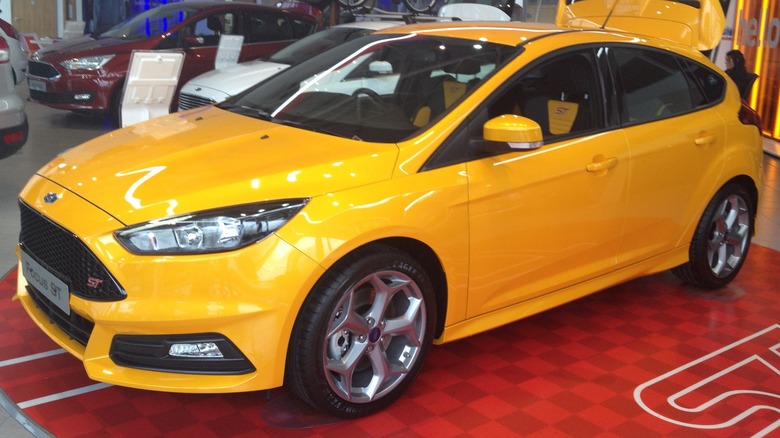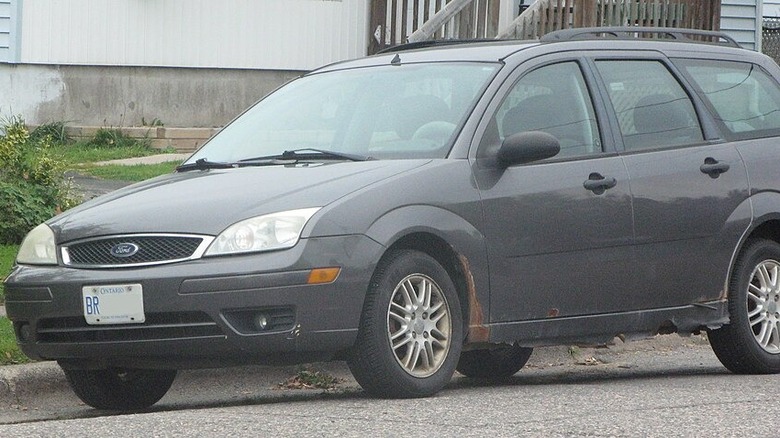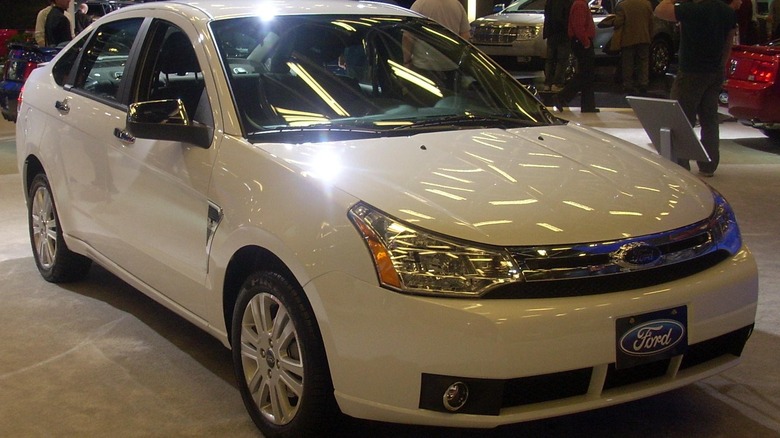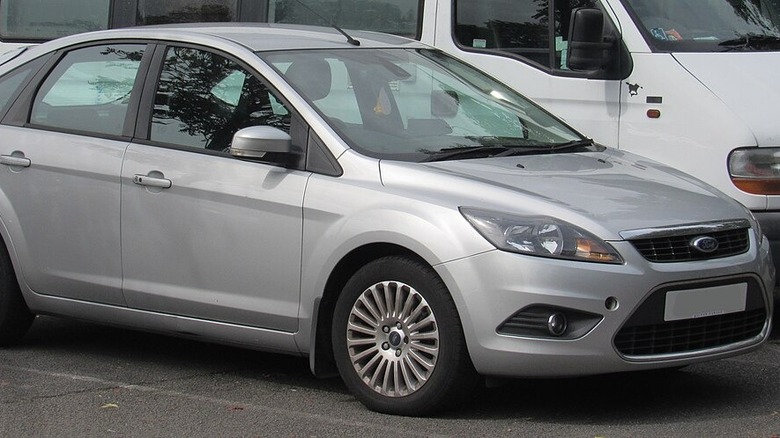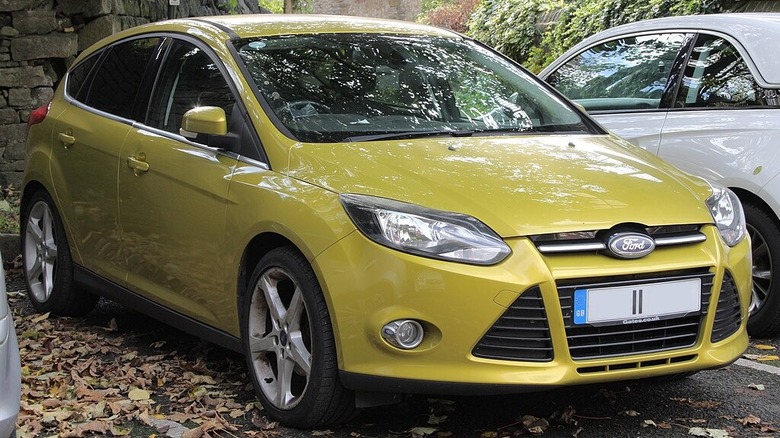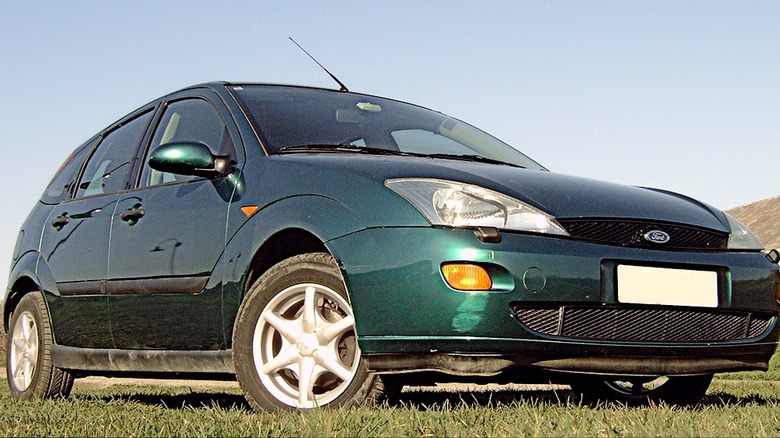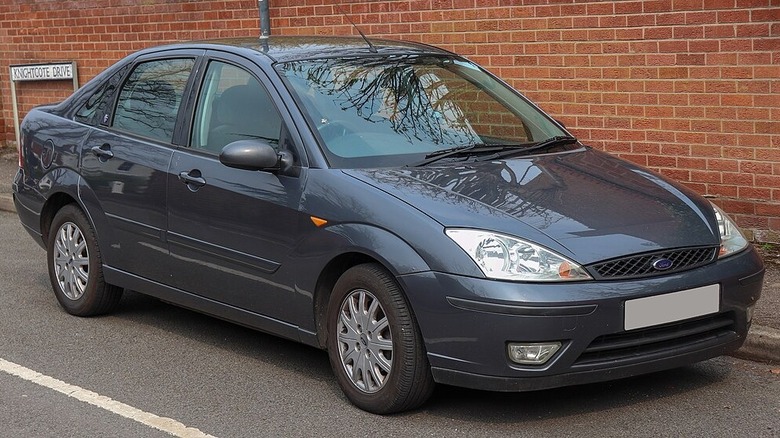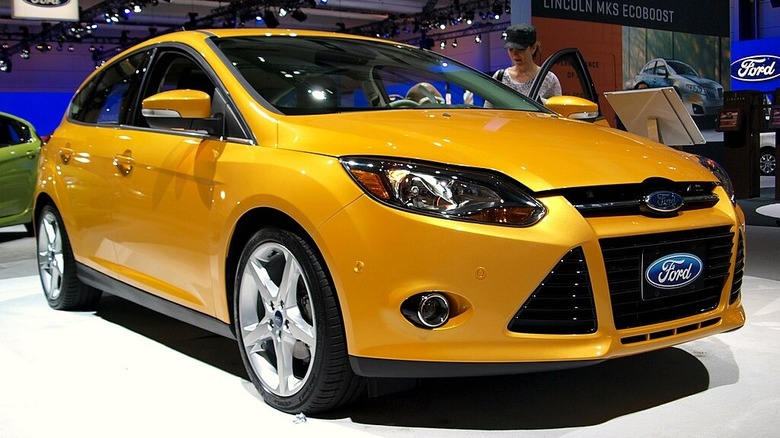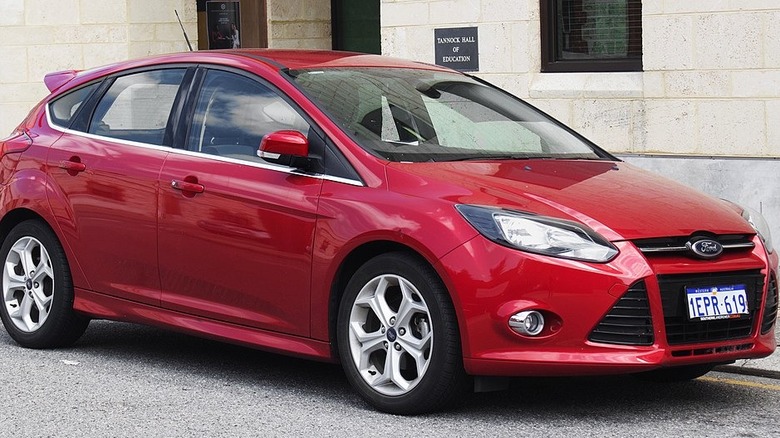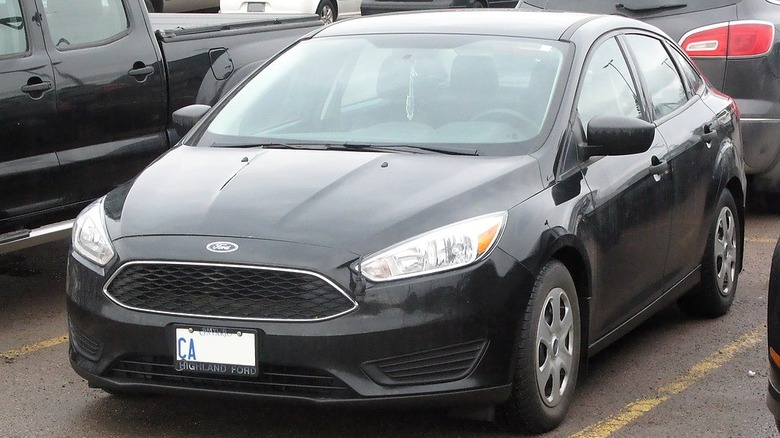The Best Years For The Ford Focus, And Some To Avoid (According To Users)
Ford once had a pretty vast array of cars in its lineup. Nowadays, that is not the case. Aside from the Mustang, everything that the company sells for regular passenger usage is either a pickup truck or an SUV. They could be gas-powered, electric, or hybrid, but those are the selections you are going to get. One of the more famous castoffs from the Ford brand in the 21st Century is the Ford Focus. Well, in the United States, at least; the Focus is still being made for other territories around the world. It arrived in America for the 2000 model year and discontinued the car in 2018.
The Focus was a fairly ordinary compact car that you could get as a two-door coupe, a four-door sedan, or even a hatchback, and despite its relatively brief production run, it is one of the best-selling vehicles that Ford has ever produced, with over 9 million sold in that time. Years after its end, there are many reasons why someone would want to get a Focus on the used vehicle market, from affordability to efficiency, but within those 19 production years, the car had its high and low points. If you are in the market for a Ford Focus, we are going to run down four different model years you will want to definitely give a look at, and four you should skip over entirely. These recommendations are based on ratings and reviews from actual customers for the Ford Focus, though reliability ratings and reviews from professional publications will also be taken into consideration.
[Featured image by Vauxford via Wikimedia Commons | Cropped and scaled | CC BY-SA 4.0]
Best: 2006 Focus
If the age of a vehicle does not deter you from a used car, then the furthest back you will want to go for the Ford Focus comes from the 2006 model year. When the Focus began in 2000, nearly every single year was plagued by a variety of different issues, leading to hundreds upon hundreds of submitted problems by drivers on CarComplaints. By the time 2006 rolled around, Ford had worked out a good deal of the kinks from those previous models, and this particular model had less than 25% of the reported complaints than the models from a few years earlier.
A lack of issues does not necessarily mean that there is praise for the car, but that praise from drivers can be easily found. Customers submitting ratings and reviews on both Kelley Blue Book and Cars.com have given the 2006 Focus an average rating of 4.1 out of 5 stars on each website. Meanwhile, the reviews on Edmunds are even better, earning 4.4 stars and frequently spotlighting the car's value, fuel efficiency, reliability, and ride quality. Consumer Reports was never particularly kind to the Ford Focus in its ratings, but the 2006 model is the rare exception, with the highest owner satisfaction rating for the entire first generation of the car. The 2006 Ford Focus was clearly when this car became a solid, universally well-liked car for drivers, and it is pretty easy to find a model sold for under $3,500.
[Featured image by SsmIntrigue via Wikimedia Commons | Cropped and scaled | CC BY-SA 4.0]
Best: 2008 Focus
The first generation of the Ford Focus in the United States was rather up and down in terms of drivers finding things wrong with their cars. 2006 was a bright spot, but the submitted issues on CarComplaints crept up again in 2007. Luckily, it would not take long for Ford to right the ship after that, as the 2008 model saw those complaints go back down. Plus, the customer ratings for this particular model year were quite high across the board.
The biggest increase in rating from 2006 came from the drivers on Kelley Blue Book, raising the overall average by a half-star to 4.6 out of 5 stars. Those 4.6 stars would be matched on the average by customers on Edmunds as well. Although that wasn't as big of an increase from 2006 as Kelley Blue Book, Edmunds drivers were already more taken with the Ford Focus. It didn't reach 4.6 stars, but Cars.com also saw an overall average increase to the 2008 model with an average score of 4.4 stars. No matter where drivers are getting their cars from, they are coming away happy.
The folks over at J.D. Power agree with the high praise. With an overall score of 79 out of 100, it is tied as the second highest-rated Ford Focus that the company has rated, thanks to a quality and reliability score of 80 and a driving experience score of 86. Drivers clearly found a lot to love about the 2008 Ford Focus.
[Featured image by Bull-Doser via Wikimedia Commons | Cropped and scaled | Public Domain]
Best: 2010 Focus
Although those 2006 and 2008 models were both high-quality vehicles, it wouldn't really be until the true, final years of this generation that the Focus would truly come into its own. That began with the 2010 model year, which is the second recommendation on this list if you're looking for a used car. Not only did the reported issues for this model go down, but the customer ratings for it went up as well.
The drivers on Cars.com have given this an overall average of 4.5 out of five stars, citing a comfortable ride feel and its more modern multimedia system as positives. Over on Kelley Blue Book, customers went even a little higher than that with a 4.6-star rating, a full half-star higher than in 2006. While the Edmunds customer rating remained 4.4 stars like the 2006 model, staying consistent at that level is much better than going down. Also, no driver has given it a one-star review on that site.
J.D. Power agrees with these high ratings for the 2010 Focus. In fact, this model year is the highest-rated Focus of any year, with an overall score of 81 out of 100, making it the sole model to get over 80. Its quality and reliability score was even better at 85. In many respects, the 2010 Focus should maybe be first on your list.
[Featured image by Makizox via Wikimedia Commons | Cropped and scaled | CC BY-SA 4.0]
Best: 2011 Focus
You do not need to go much further into the future to find the next best Ford Focus because it is the very next model year. The 2011 model — the final one for this generation of the car — is just as quality a model as the 2010, and in some cases, people would even rate it better than that car. First and foremost, we have ratings from the likes of Kelley Blue Book, Cars.com, and Edmunds. All of these are identical star ratings to the 2010 model, with 4.6 stars, 4.5 stars, and 4.4 stars, respectively. That shows the impressive consistency Ford is able to achieve at this period of the car. After all, this model has been around since 2000, and you would hope that the company had refined it by this point.
While J.D. Power isn't quite as positive as the 81 out of 100 given to the 2010 model, the 2011 Focus still earns a totally solid overall score of 79 from the publication, which is tied with the 2008 model as the second highest for a Focus. Its quality and reliability score is still impressive, with an 83 out of 100 rating. Consumer Reports concurs with J.D. Power in its reliability rating for the car, giving it the highest reliability score for any model year. On CarComplaints, this model year also has the fewest submitted issues from drivers on CarComplaints of this entire generation of the car. Between the 2010 and 2011 models, Ford really got the Focus right.
[Featured image by DieselFordMondeo via Wikimedia Commons | Cropped and scaled | CC BY-SA 4.0]
Avoid: 2000 Focus
The Ford Focus came over to the United States for the 2000 model year, and while its sales figures were incredibly impressive, reactions from drivers were decidedly not. Instead, it was plagued with a great deal of problems, making it one of the model years with the most submitted issues from customers on CarComplaints. The most common complaint issued is one that you rarely see, as it feels like something that Ford would have caught very early in production. There were dozens upon dozens of drivers not being able to turn on their cars because their keys would not fit in the ignitions, and if it did, that did not guarantee that it would actually be able to actually turn the ignition on. For a car to be worthwhile, you would like it to operate.
If that wasn't bad enough, there were also dozens upon dozens of complaints regarding the engine's performance. Most notably, there were many instances of the engine dying while driving, as well as the engine just being blown in general. So, if you happened to get a 2000 Ford Focus where your key could fit perfectly in the ignition, that does not mean that your car would run properly anyway. Overall, the model was subject to 18 different recalls, and none of them addressed these significant issues that many drivers had. Instead, they focused on things like electrical system failures and safety issues regarding the car's structure, wheels, and seats. Get far away from the 2000 Ford Focus.
[Featured image by Kallemax via Wikimedia Commons | Cropped and scaled | Public Domain]
Avoid: 2003 Focus
None of the first four years of the Ford Focus could escape trouble. Each model year accumulated hundreds of issues from drivers on CarComplaints, and the highest among them was the 2003 model. As for why this model was so problematic for so many customers, you might think that it would be something separate from the key issue that we saw back with the 2000 model, but you would be wrong. Amazingly, Ford put out a car that still received hundreds of complaints of people not being able to turn their keys in their ignitions to start their cars. The 2001 and 2002 models had this problem too, but they aren't nearly as prevalent as with the 2003 Focus. It boggles the mind how such a popular vehicle had a not insignificant portion of buyers who couldn't start it.
The key problem wasn't the only carryover that made its way from the 2000 model. There were still plenty of instances of engine failure as well, including while driving. If the engine didn't fail if you were able to get it started, then maybe it would be the transmission that would fail, as there were a number of submitted claims of that happening as well. While 2000 and 2003 are two models from the first four years that are specifically named on this list, your best option is to avoid all four of them. Clearly, none of them can be relied upon.
[Featured image by Vauxford via Wikimedia Commons | Cropped and scaled | CC BY-SA 4.0]
Avoid: 2012 Focus
You may have noticed that every single recommendation for a Ford Focus that you should look into for a used car came from the first generation of the vehicle. That is because the customer ratings for the second generation go off of a cliff, starting with the 2012 model that kicked off the second — and final — generation in the United States. This is particularly evident with the average ratings on Edmunds, which struggle to surpass 3 stars on a regular basis. The 2012 model earned 3.3 out of five stars on Edmunds, and that is on the higher end for the Focus. The reviews point out the faults in everything from its reliability to its excessive maintenance to there even being issues with the cupholders. On Consumer Reports, the 2012 Focus has a one out of five owner satisfaction rating and an 18 out of 100 reliability rating. These are just awful numbers.
This is also the model year with the most submitted problems from drivers on CarComplaints of all. Luckily, Ford had fixed the key issue by this point. Instead, the number one issue plaguing the 2012 Focus was the transmission, and there isn't one consensus problem with the transmission either, as shifting problems, transmission failure, and scary vibration noises all have relatively similar numbers of complaints. Beyond the transmission, power steering failure was another huge issue, and there was a widespread recall of faulty door latches. Just as the first generation started poorly, so did the second generation with the 2012 model.
[Featured image by Michael Gil via Wikimedia Commons | Cropped and scaled | CC BY 2.0]
Avoid: 2014 Focus
Just two years later, you might think that Ford would have improved its vehicle, but it instead made arguably the worst model of the Ford Focus of all. If you thought 3.3 stars for the 2012 model was bad, drivers on Edmunds have given the 2014 model an average of 2.3 out of 5 stars, with nearly half of the customers giving it a one-star rating. Reviews use phrases like "transmission nightmare" or "junk" to describe it. One of them even calls for a class-action lawsuit for how terribly made this car is. Consumer Reports clearly agrees as well, giving this model another one out of five owner satisfaction score.
Although it does not have as many problems submitted by drivers as the 2012 model, the 2014 model is what CarComplaints determines to be the worst Ford Focus of all time. However, the reason is simple: a poor transmission. About 63% of all of the submitted complaints with this model concern the transmission, and while one of the vehicle's six recalls concerned a transmission leak, this was not a primary issue drivers were encountering. Instead, people were finding problems with transmission halting, stuttering, and more, particularly when in a stopped position. When hundreds of people are dealing with the same issue and the company does nothing about it — leaving you with costly mechanic bills — that puts an undue burden on the driver they shouldn't have.
Also, if it wasn't obvious having 2012 and 2014 on this list, you should steer clear of the 2013 Ford Focus as well.
[Featured image by EurovisionNim via Wikimedia Commons | Cropped and scaled | CC BY-SA 4.0]
Methodology
Opinions on the Ford Focus vary quite a lot depending on where you look. The aim of this particular article was to find something of a consensus amongst drivers who have purchased and operated a Ford Focus themselves in order to best educate those looking to purchase a used car as to which models were the best and which were the worst. Primarily, this was done by examining the average customer ratings and reviews from different sites, such as Edmunds, Kelley Blue Book, and Cars.com, which are not only reliable metrics but also are able to attract a plentiful number of reviews.
Beyond that, the ratings from publications like J.D. Power and Consumer Reports were of great importance, particularly when it comes to reliability and owner satisfaction. The number of recalls a particular model year had to undergo also played a factor, as well as how many submitted issues from drivers they received on CarComplaints. Not only was the number of problems important, but so was the consistency of those problems. Once all of these elements were brought together, we could determine four models of the Ford Focus that are well worth your time and four that couldn't be less worth it.
[Featured image by SsmIntrigue via Wikimedia Commons | Cropped and scaled | CC BY-SA 4.0]
